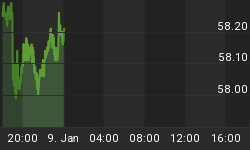"Most of mainstream macroeconomics is dead. It's a zombie. Theydon't know they're dead yet, but they're dead." ~ L. Randall Wray, Bloomberg Businessweek, 17 January 2011
Above wisdom came from the opening article in Bloomberg Businessweek titled, "Back to the Economic Future." Not in many decades has a mainstream American business publication reminded readers that some innovative thinking has occurred in the field of economics since the British Socialist Keynes introduced his ideas for government control of economic activity. To some the response to this article might be, "Hayek who?" To those that have spent some time doing a little research the response would be, "Hayek. He was right all along!" Regrettably, little thinking has gone on in academic economics since Hayek's passing.

Despite widespread global condemnation and rejection of U.S. Federal Reserve policies, that body continues on a path that has already failed utterly TWICE in the last decade. In the above graph we see that Bernanke's Bubble, ownership by the Federal Reserve of U.S. debt, now surpasses that of either China or Japan. Those two nations have apparently come to understand that economics might be like baseball. For those of you not familiar with the rules of this most boring of games, three strikes and you are out. Most of us recognize that the Federal Reserve is preparing to make that third strike.
Learning at the Federal Reserve from past mistakes is a lot like training a cat. Neither is apparently possible. Investors, perhaps because they are using their own money, have learned from decades of economic policy mistakes. In doing so, a mechanism has been identified as capable of fending off some of the negative ramifications of Keynesian economics. Gold, with its value determined by a whole world of investors, is that mechanism. No economist is permitted to determine the price of Gold. If they were permitted to do so, we would have to seek out an alternative.
With all the above said, nothing precludes a market from being run to an extreme during a period of debt monetization by the central bank. Nothing in the history of Gold says that its price cannot be pushed to above reasonable value. Such was the case at the end of 2010.
Bubble? What does it matter what it is called. That Gold is now correcting that excess can no longer be denied. At US$1,281 the talking heads will declare a bear market, as that price would represent a 10% correction. At about that level it will also be testing the 200-day moving average.
Bear markets are opportunities. The math of finance tells us that as price declines future returns rise. That means that if Gold is to be our defense against the Keynesian evil, it should be bought when oversold, or when the price is down. To borrow a phrase, "I love the smell of a bear market in the morning."

Above graph may be one of my favorites. It is of the 20-year return on U.S. equities and $Gold using wealth indices. First, U.S. equity markets, and many others, have produced nothing but volatility in the past decade. For more than ten years, Keynesian policies have done nothing but raise the total investment risk in equities, as measured by the variance of returns.
When those two lines cross, and ultimately they will, that Keynesian economics and U.S. Federal Reserve policy have been intellectually bankrupt for decades will be painfully obvious. Even the delusional staff of the Federal Reserve will have to acknowledge failure. In the meantime, use weakness in this bear market for Gold to add to positions on price dips. Remember the rule: Buy low. But also remember the second rule: Be careful when attempting to grab a falling knife.
In closing, a thought stolen from an unknown commentator. How does a Keynesian economist's brain cell die? Alone.
GOLD THOUGHTS come from Ned W. Schmidt,CFA,CEBS as part of a joyous mission that has saved a multitude of investors from the financial abyss of paper assets. He is publisher of The Value View Gold Report, monthly, and Trading Thoughts, about weekly. To receive these reports, go to: www.valueviewgoldreport.com
















